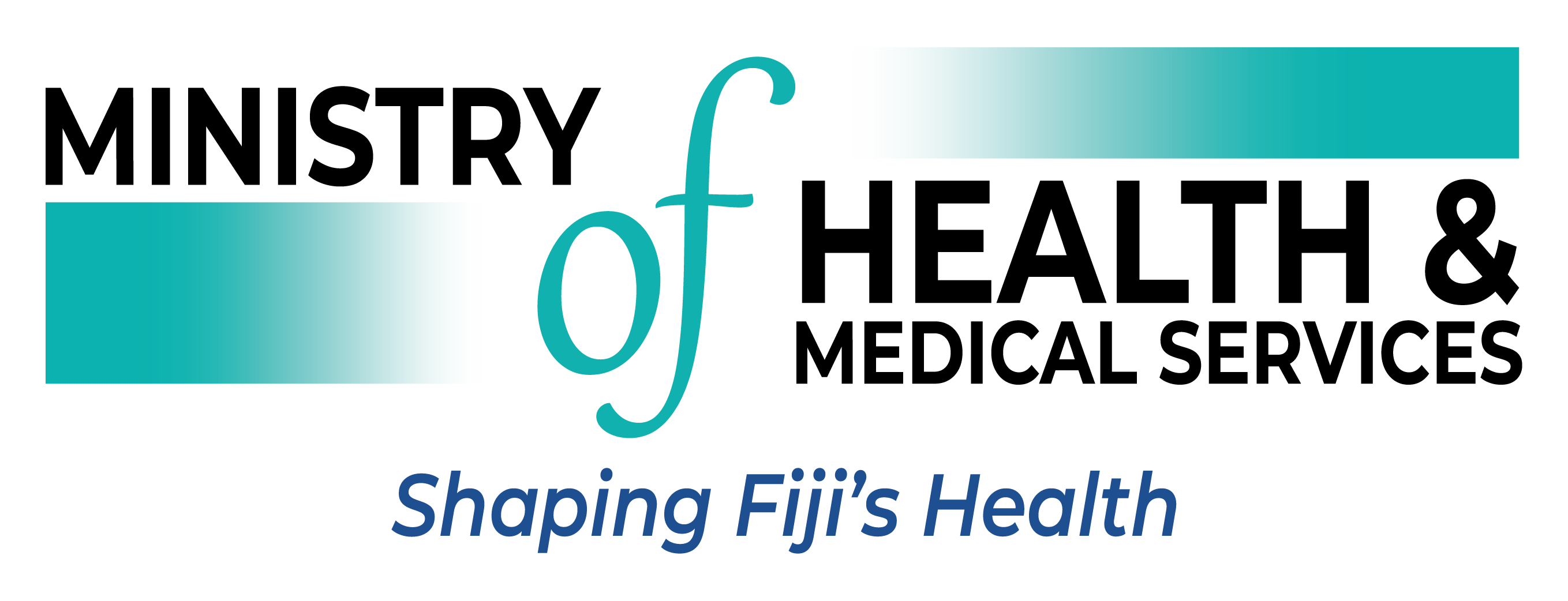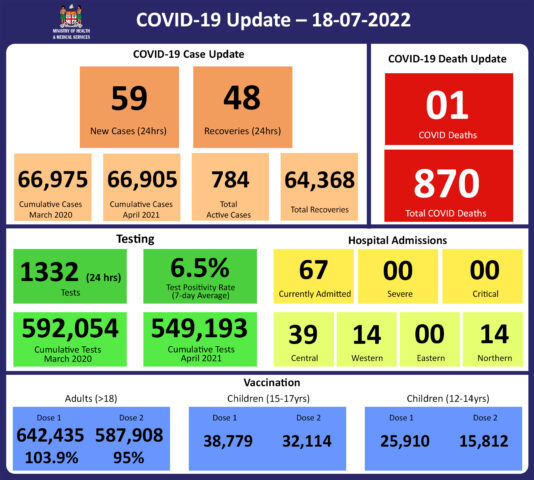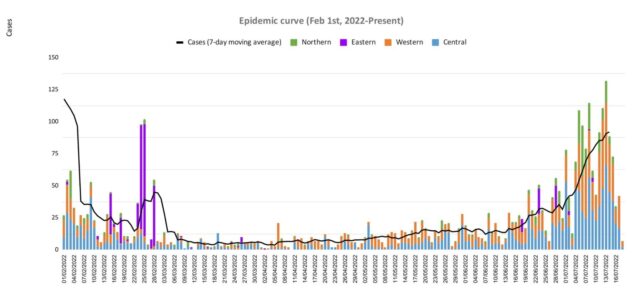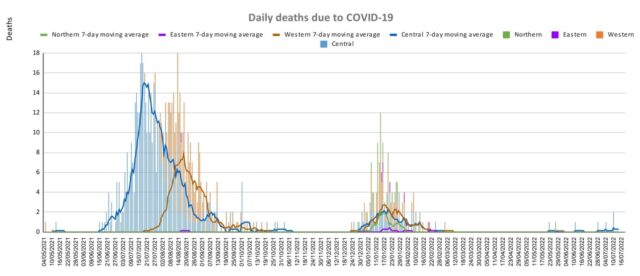COVID-19 Update 18-07-2022
COVID-19 Update
Monday 18th July
| Transmission Update:
Since the last update on 14th July, we continue to observe an increasing trend in case numbers reported and complied. The national 7-day rolling average of cases as of 14th July is 92 daily cases. We have recorded 268 new cases of which 97 new cases were recorded on 15/07/2022; 71 cases on 16/07/2022; 41 cases on 17/07/2022 and 59 new cases in the last 24 hours ending at 8 am this morning. Of the 268 cases recorded, 129 cases were recorded in the Central Division; 122 cases in the Western Division; 17 cases in the Northern and nil cases were in the Eastern Division. The Central Division cases constitute 67% of the cumulative total cases nationally, with the Western division making up 28%, 3% in the Northern Division, and 2% in the Eastern Division. |
||||||||||||||||||||||||||||||||||||||||||||||||||||||||||||||||||||
| Deaths:
The curve depicts daily COVID-19 deaths by division since May 2021. It indicates a surge from last December, with peaks in mid-January 2022 followed by a downward trend. The latest COVID death was reported on 18/07/2022. COVID Death Reports We have one new COVID-19 death to report. The COVID-19 death to report is of an 82-year-old male from the Central Division who presented to Raiwaqa Health Centre in respiratory distress on 09/07/2022. He was transferred to the CWM COVID ward, but sadly, passed away on 18/07/2022. Although he was 3 dose vaccinated, he had multiple pre-existing medical conditions which worsened his COVID state. Analysis of Deaths Table 1: Death rates by Division
An analysis of the 169 deaths recorded since December 2021, shows that the Central Division has the highest absolute number of deaths, and the Northern Division has the highest rate of death when adjusted for population. Table 2: Deaths by Age Group
For the 169 deaths since December 2021, the death rate adjusted per 100,000 population, has been highest in age groups 50 and onwards. There were 8 deaths below the age of 19 years, 7 out of the 8 children had significant pre-existing medical conditions, and one child had no known underlying medical condition. Table 3: Deaths by Vaccination Status
Out of 169 COVID-19 deaths reported since December 2021, six (6) deaths were in the population not eligible for vaccination (under age 12). An analysis of the 16 deaths in the vaccine-eligible population reflected, that when adjusted per 100,000 population, for fully vaccinated (received 2 doses) and unvaccinated/not fully vaccinated (received 0 doses or only 1 dose) adults in Fiji, we have a death rate of 10.8 per 100,000 population for fully vaccinated adults and 320.5 per 100,000 population for unvaccinated adults. This means that unvaccinated adults in Fiji have been dying at a rate 29.6 times higher than fully vaccinated adults. Individuals in the 12-17 age group who died were not vaccinated. There is one (1) individual who recently died due to COVID-19 and had received the 3rd Booster dose. There have been a total of 870 deaths due to COVID-19 in Fiji. As of July 14th, 2022, the national 7 days rolling average for COVID-19 deaths per day is now 0.4, with a case fatality rate of 1.29%. Due to the time required by clinical teams to investigate, classify and report deaths, a 4-day interval is given to calculate the 7 days rolling average of deaths, based on the date of death, to help ensure the data collected is complete before the average is reported. We have also recorded 951 COVID-19-positive patients who died from other serious medical conditions unrelated to COVID-19; their doctors determined that COVID-19 did not contribute to their deaths, therefore these are not classified as COVID-19 deaths |
||||||||||||||||||||||||||||||||||||||||||||||||||||||||||||||||||||
| Hospitalization:
Using the WHO clinical severity classification, there are 91% (n=61) cases in the asymptomatic and mild categories; 2% (n=1) in the moderate category; 7% (n=5) in the severe category and nil cases in the critical category. Anyone admitted to the hospital is tested before admission, therefore, a significant number of people are admitted to the hospital for non-covid health conditions, but incidentally, test positive due to the high amount of transmission in the community. |
||||||||||||||||||||||||||||||||||||||||||||||||||||||||||||||||||||
| Testing:
1332 tests have been reported for July 17th, 2022. Total cumulative tests since 2020 are 592,054 tests. The 7-day daily test average is 1,301 tests per day or 1.5 tests per 1,000 population. The national 7-day average daily test positivity is 6.5% which is above the WHO recommendation of 5%. The positivity rate is an indication of widespread community transmission. |
Public Advisory
For COVID-19;
As reported earlier, we continue to see an increasing trend in COVID-19 cases. In recent months, severe disease and death have only been seen in people with significant underlying medical conditions and the elderly. And until very recently, deaths have been of people who were not vaccinated, or were vaccinated, but had not received a booster dose. The report of another death from COVID-19, of a person with severe underlying illness, who had received 3 doses of vaccine, is a sobering reminder that COVID-19 is still a disease that must continue to be taken seriously by all. We need to escalate community-wide adoption of covid safe measures together with immunization.
We also urge everyone to stay up to date with your COVID-19 vaccination, especially people over the age of 50, and anyone with underlying medical conditions to get vaccinated and get their first and second booster doses when due. We must also be aware that the elderly, and people with underlying medical conditions are at higher risk of severe COVID-19 disease. People in this group with COVID-19 symptoms must come forward to be tested, put onto a monitored care pathway by a medical provider, and immediately brought to the hospital if severe symptoms are present”
All the hospitals have been notified to reintroduce more stringent COVID safe measures. These include restricting visitors, more strict enforcement of masking and hand sanitization practices and to strengthen screening protocols. For workplaces, we strongly advise that COVID safe measures be more actively promoted and enforced by management.
Community and Workplace leaders must bring back many of the COVID safe measures that your community and/or organisation has learnt during the acute outbreak. We need to be able to live with COVID by reducing the risk of vulnerable people getting COVID and/or suffering from severe consequences. COVID safe measures prevent us from getting COVID and also reduce the risk of spread to the more vulnerable and less mobile in the community.
Vaccines have provided a level of protection from severe disease and death such that the increasing trends in cases remain less of a concern. However, if we do not take measures to reduce the risk of getting the virus, the small percentage of people that get the severe disease will be a big number of people seeking hospital care. A large number of people seeking hospital care will mean that they compete for hospital resources with those who need emergency care. Acute cases like heart attack patients, or road traffic accident cases will become more difficult to care for. Vaccination with COVID safe measures will keep the number of people needing hospital care very low and ensure that the health care load remains manageable.
We have maintained a number of public health mandates and measures related to vaccination and incoming travel. The Ministry of Health and Medical Services envision that the more the booster dose, the better the level of protection, and the safer it will be to further remove the remaining public health measures. The Ministry is currently looking at 80% booster coverage for those over 18 years of age.
Anyone who is sick should not be attending work or school. If you have COVID-19 symptoms you must get tested for COVID-19. If you test positive- isolation is mandatory for 7 days.
The increasing trend in respiratory infections, especially in children remains an issue of concern in this current cold-weather season. This comprises a number of respiratory viruses that cause cold and flu symptoms. It has been expected that as restrictions intended to prevent transmission of COVID-19 were lifted (including mandatory masking, physical distancing, and school and border closures) other respiratory viruses that normally circulate would begin to re-emerge similar to pre-COVID levels, and possibly even at higher levels due to a decrease in population immunity to seasonal viruses, as cold/flu cases were low during the last two years.
We also note that we are in the middle of our chickenpox season, we have noted cases positive for measles and we have recorded cases of hand, foot and mouth disease; a disease that is caused by a family of viruses called enteroviruses. All these diseases can be mistaken for what many have read about monkeypox. We have yet to diagnose a case of monkeypox in Fiji. MOHMS have also released a number of advisories for the public. And we have released guidelines to all clinicians in the public and private sectors in order to facilitate early case identification and reporting.
COVID-19 Vaccination
As of the 18th of July, a total of 149,998 (48%) booster-eligible individuals have so far received their 3rd dose while 13,540 individuals have been administered the 4th dose.
Increasing Vaccine Booster Coverage Program
It is well documented that immunity against COVID-19 infection acquired from COVID-19 vaccination wanes over time. The effectiveness of protection against COVID-19 after a primary series of AstraZeneca vaccination is slightly lower than other COVID-19 vaccine products, especially against the Omicron variant of concern. However, receiving a third dose (booster), especially of mRNA vaccines like Pfizer or Moderna, boosts immunity against infection.
There is also evidence that prior infection with a non-Omicron variant or the Omicron sublineages of BA.1 and BA.2 may not protect against infection with Omicron sublineages BA.4 and BA.5, which are now dominant in some countries- though some protection against severe disease is still expected. There is no evidence that BA.4 and BA.5 cause more severe disease than previous variants. The latest genomics sequencing results show that Omicron sublineages BA.1 and BA.2 are in circulation in Fiji, while BA.4 and BA.5 have not yet been detected.
This means that, once these sub-lineages enter the community, it is expected that people may get infected, even if they have been infected before; and while the risk of severe disease is expected to remain low in those who have had 2 doses and have no underlying illnesses, increased sickness may still have a negative impact on the workforce. And people with underlying conditions like diabetes, heart disease, kidney disease etc. will h. will continue to be at higher risk of severe disease and death.
These considerations, and the noticeable current increase in cases, indicate an urgency to increase our efforts to increase booster dose coverage. The return of most of the medical immunisation staff has also helped to ensure support for escalating our vaccine booster coverage program.
Based on this and international evidence the Ministry recommends booster dose interval for eligible persons over 18 years be reduced to 3 months after the 2nd dose in recognition;
- of the risk of disease surge based on waning 2 doses of COVID-19 vaccine protection
- slow booster uptake
- increased international travel with the relaxation of border measures
- ongoing outbreaks in various parts of the world with an increase in Omicron sublineages that may evade infection-induced immunity from other variants
Hence, we urge the public to get booster vaccine doses with a list of vaccination sites provided daily by the MHMS. Currently, both Pfizer and Moderna are recommended for booster doses.
In order to optimise coverage, the aim of the booster campaign is to administer 250,000 doses of Pfizer vaccine to those who have completed the primary series (doses 1 and 2) > 3 months prior but have not yet received a booster dose. This requires a minimum of 32,000 doses to be administered weekly for 8 weeks from 1 June to 31 July 2022.
COVID-19 booster priority populations are;
- Persons over the age of 18 years who have completed their primary series > 3 months prior can receive their 1st booster dose
- Immunocompromised persons and those over the age of 60 years who had received the 3rd booster dose, may receive the 4th dose after a period of 4 months
- Health care workers, port staff, tourism and others who wish to receive a 2nd booster dose may receive it after an interval of 4 months from their first booster dose.
- Anyone over 18 years who have taken their 1st booster dose can receive a 2nd booster dose after an interval of 4 months.
COVID-19 vaccination to the 5-11 years in Fiji.
Overall Plan
The Vaccination Roll was started in the Central Division on Wednesday 6th July. While we had hoped for rapid and broader deployment the stringent cold chain logistics do need further strengthening to support further deployment, to the Western Division then Northern and Eastern Division.
The Ministry of Health and Medical Services is committed to:
- Equitably allocating sufficient doses to vaccinate all the 132,893 children aged 5-11 in Fiji.
- Equitably track and position vaccine sites to ensure that eligible individuals can receive vaccines in a safe and timely fashion.
- Provide evidence-based, unbiased information on vaccine safety, physical distancing, and mask-wearing to maximize the impact of these vaccines.
The Fiji Action Plan for COVID-19 vaccination of children aged 5-11 is three- folds approach to;
(1) Identify and prioritize eligible individuals and communities,
(2) Engage those individuals and communities with a targeted outreach and communication plan and (3) administer the vaccines.
Administration of Vaccine
The Ministry of Health and Medical Services through the 22 Sub Divisions with our School Health Teams have been leveraged to carry out the planned Vaccination rollout.
All school sites have been contacted to be potential vaccination sites.
The Health Facilities will also host vaccine clinics, as well as Pfizer vaccine clinics on weekends and the School Holidays.
The Sub Divisional Mobile Teams will also implement a homebound vaccination program that will be available to ensure that homebound children aged 5-11 will have access to immunizations if not available through their Schools.
Vaccine Clinics
Sites that have been identified for the administration of the Pfizer-BioNTech vaccine include;
- Current Fixed MCH clinics operated daily for those children of 5-11 years who would want to access these facilities.
- Mobile vaccine clinics for the Early Childhood Education Centres.
The Vaccination Teams will be visiting the Schools to conduct vaccination according to the planned dates.
Other schools identified as priority community vaccination locations are the special schools that cater for children with special needs.
Opportunities may be offered to the sites that are hosting community events (sporting, etc.)
The Consent Process
Consent is obtained through the Consent Form of a parent or guardian for allowing their child to receive the age-approved vaccination.
The consent process includes;
Onsite consent is to be provided by a parent or guardian who is physically present with the minor at the vaccine site. The parent or guardian will sign an appropriate vaccine administration Consent Form.
For Off-Site consent:
- A consent form can also be taken home by children to be signed by the parent or guardian
- A letter can also be written/typed and signed by the parent or guardian.
- The acceptance of a letter of consent must be documented by the Vaccination Team and the letter should be retained with the patient record.
- The presence of a support person will be accommodated at all vaccine sites
Consent and Vaccine Information Documentation:
The Consent Form includes information on demographics (name and DOB), questions asked by the parents or support person and a place for the parent/guardian’s signature. Your questions will be dealt with by the vaccine provider.
The Vaccination Card indicates approval to release identifiable information to medical providers, and a place for the vaccinator to note the date (1st and 2nd Dose), a batch number and the type of vaccine.
The Consent forms are accompanied by a vaccine information booklet.
LTDD Update
Leptospirosis cases remain above the outbreak threshold in West and in Central. In the western division, there is a downward trend however it is a concern that leptospirosis in the Western division has remained above the outbreak threshold consistently this year. Nationally, admissions and death due to leptospirosis continue on a downward trend. Although we reported a spike in Typhoid cases in the Northern division recently when 3 cases were reported in a week, Typhoid case trends remain below outbreak and alert thresholds. Dengue case trends also remain below outbreak and alert thresholds.
Last Updated on 2 years by Publishing Team



